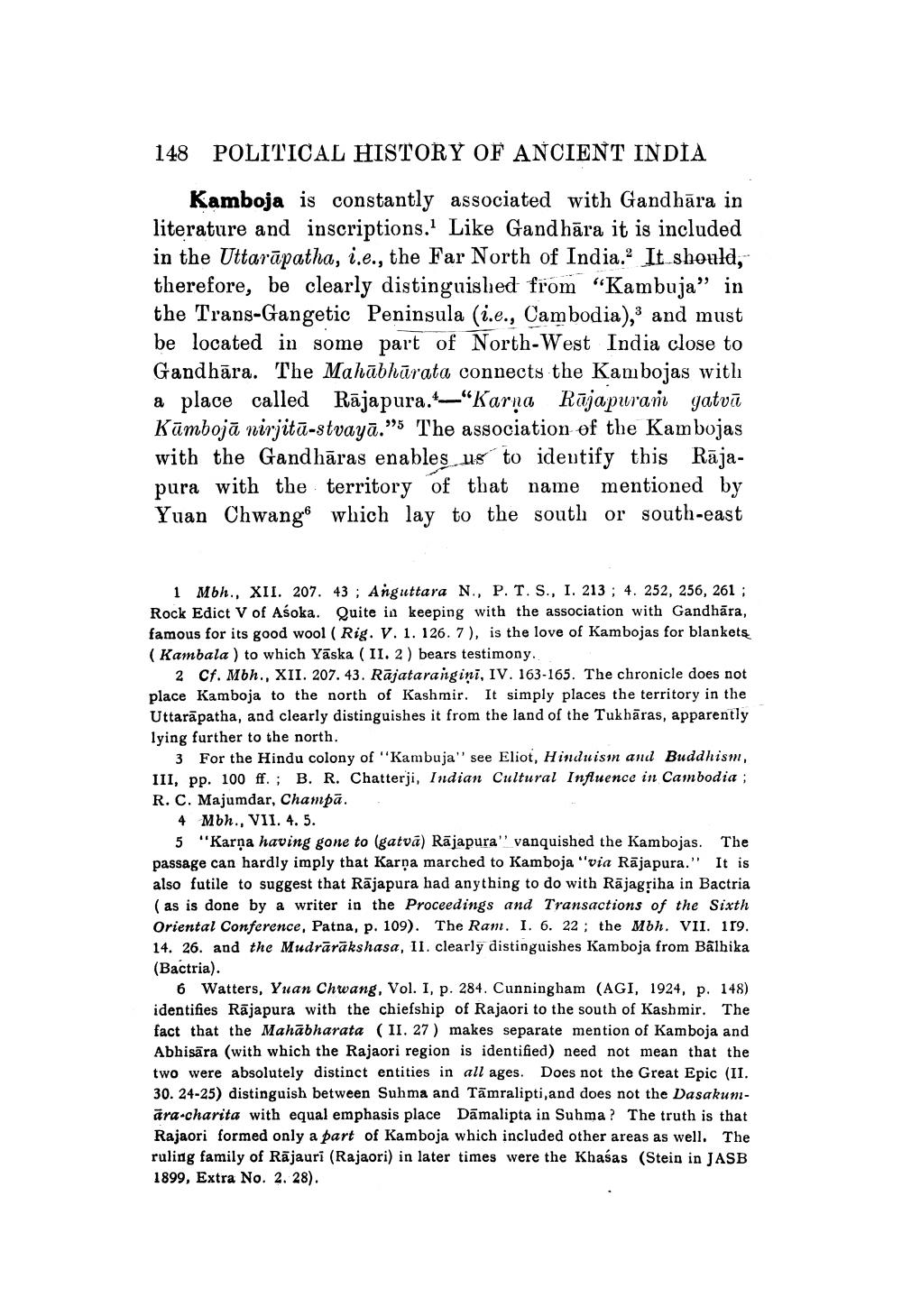________________
148 POLITICAL HISTORY OF ANCIENT INDIA
Kamboja is constantly associated with Gandhāra in literature and inscriptions. Like Gandhāra it is included in the Uttarāpatha, i.e., the Far North of India. It should, therefore, be clearly distinguished from "Kambuja" in the Trans-Gangetic Peninsula (i.e., Cambodia), and must be located in some part of North-West India close to Gandhāra. The Mahābhārata connects the Kambojas with a place called Rājapura. "Karna Rājapuran gatvā Kāmbojā nirjitā-stvayā."5 The association of the Kambojas with the Gandhāras enables us to identify this Rājapura with the territory of that name mentioned by Yuan Chwange which lay to the south or south-east
1 Mbh., XII. 207. 43 ; Anguttara N., P. T. S., I. 213 ; 4. 252, 256, 261 ; Rock Edict V of Asoka. Quite in keeping with the association with Gandhāra, famous for its good wool (Rig. V. 1. 126. 7), is the love of Kambojas for blankets (Kambala ) to which Yāska (II. 2) bears testimony.
2 Cf. Mbh., XII. 207. 43. Rājatarangini, IV. 163-165. The chronicle does not place Kamboja to the north of Kashmir. It simply places the territory in the Uttarāpatha, and clearly distinguishes it from the land of the Tukhāras, apparently lying further to the north.
3 For the Hindu colony of "Kambuja'' see Eliot, Hinduism and Buddhism, III, pp. 100 ff.; B. R. Chatterji, Indian Cultural Influence in Cambodia ; R. C. Majumdar, Champā.
4 Mbh., VII. 4. 5.
5 "Karna having gone to (gatvā) Rājapura" vanquished the Kambojas. The passage can hardly imply that Karna marched to Kamboja "via Rājapura." It is also futile to suggest that Rājapura had anything to do with Rājagriha in Bactria (as is done by a writer in the Proceedings and Transactions of the Sixth Oriental Conference, Patna, p. 109). The Ram. I. 6. 22; the Mbh. VII. 119. 14. 26. and the Mudrārākshasa, II. clearly distinguishes Kamboja from Balhika (Bactria).
6 Watters, Yuan Chwang, Vol. I, p. 284. Cunningham (AGI, 1924, p. 148) identifies Rājapura with the chiefship of Rajaori to the south of Kashmir. The fact that the Mahabharata (II. 27 ) makes separate mention of Kamboja and Abhisāra (with which the Rajaori region is identified) need not mean that the two were absolutely distinct entities in all ages. Does not the Great Epic (II. 30. 24-25) distinguish between Suhma and Tāmralipti and does not the Dasakumāra-charita with equal emphasis place Dāmalipta in Suhma? The truth is that Rajaori formed only a part of Kamboja which included other areas as well. The ruling family of Rājauri (Rajaori) in later times were the Khasas (Stein in JASB 1899, Extra No. 2. 28).




